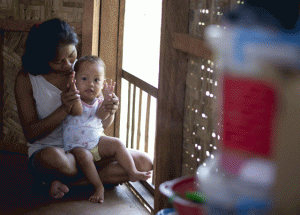TACLOBAN: Emily Sagalis gave birth on a concrete slab after battling storm surges that killed thousands, then like many new mothers in razed communities began another perilous struggle for survival with her baby.
About 250,000 women were pregnant in areas hit by Super Typhoon Yolanda (Haiyan) a year ago, and in the weeks that followed babies were born on shattered roads alongside corpses, in the rubble of destroyed buildings and other places where exhausted mothers lay without adequate or any medical care.
Successful deliveries, such as for Emily, became powerful moments of hope for traumatized families struggling in the typhoon’s desperate aftermath, as well as for those involved in a massive international relief effort.
The strongest winds ever recorded and storm surges higher than two-storey buildings destroyed entire towns in already poor farming and fishing areas, killing or leaving missing more than 7,350 people.
“She is my miracle. I’d thought I would die with her still inside me, when high waves came and took us all away,” Emily, then 21, told Agence France-Presse as she lay on the concrete slab moments after giving birth to Bea Joy.
The birth took place three days after Haiyan amid the ruins of the airport in Tacloban, one of the worst-hit cities.
Emily had survived the tsunami-like storm surges, which killed her mother-in-law and wiped out her shanty home, by holding onto a fence with one hand and protecting her swollen belly from crashing debris with the other.
She then rested at an evacuation center with hundreds of other survivors, before going into labor and frantically catching a tricycle to the airport, where the military had set up a makeshift hospital.
But for every “miracle baby,” many others died because of a lack of medical care shortly after the typhoon, and then over the next year from malnutrition, illness and other complications, according to aid groups such as Save the Children and UNICEF.
“We know mortality goes up for newborns in a typhoon affected community,” Save the Children Philippine country director Ned Olney said.
There are no official figures for the number of babies who died in the year after the typhoon.
But an average of 750 babies have been born every day in the typhoon-hit communities, including during those initial weeks and months when access to medical care was at its worst, according to Olney, whose organization played a big role in providing aid to newborns and children.
“It was common that children were being born every day on the side of the road wherever there was space, in unhygienic conditions,” Olney said.
Bitter start
Even for the babies that survived, most begun their lives in bitter poverty.
Emily and her husband, Jobert, spent the first few months after the disaster living in a shanty on the same site as their previous home in San Jose, a small fishing town facing the Pacific Ocean.
When Agence France-Presse visited them three months after the typhoon, the trio was completely reliant on the food, money and other aid donated by relief organizations.
Living at the site of so much death haunted them.
However, at least their shelter was packed with sacks of donated rice and canned goods, while a charity group had set up a tent nearby from which it was giving out hot meals for mothers and their children.
A year after the typhoon, Jobert, Emily and Bea Joy’s lives are much more desperate.
They are living in a temporary shelter built by a Canadian aid group next to their old home, but it has no electricity, toilet or running water, and the thatch walls fail to keep out heavy rain.
The emergency aid stopped flowing many months ago and Emily, who is still breastfeeding, has lost a lot of weight. Rotting teeth are revealed when a smile flickers across her face while playing with Bea Joy.
A few weeks ago, their food stocks dwindled to almost nothing, with Jobert having to buy from local stores on credit and still spend days without eating.
“They are my family so they ate what we had,” said Jobert, whose skin clings tightly to his bones.
“I couldn’t let them go hungry. Sometimes I cried. But as long as they could eat, that’s all that mattered.”
They have since taken a tentative step away from that precipice, with Jobert securing a two-month contract doing manual labor for P260 a day.
“But we don’t know what will happen after that,” said Emily.
Still Emily and Jobert insist they have fortunate lives, thanks to Bea Joy.
“When we are here in our house, just the three of us, playing and cooking, then we are happy . . . she is our happiness,” Emily said.
AFP


